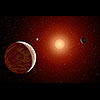Feature Story
NASA Telescope Ferrets Out Planet-Hunting Targets
Astronomers have come up with a new way of identifying close, faint stars with NASA's Galaxy Evolution Explorer satellite. The technique should help in the hunt for planets that lie beyond our solar system, because nearby, hard-to-see stars could very well be home to the easiest-to-see alien planets.
The glare of bright, shining stars has frustrated most efforts at visualizing distant worlds. So far, only a handful of distant planets, or exoplanets, have been directly imaged. Small, newborn stars are less blinding, making the planets easier to see, but the fact that these stars are dim means they are hard to find in the first place. Fortunately, the young stars emit more ultraviolet light than their older counterparts, which makes them conspicuous to the ultraviolet-detecting Galaxy Evolution Explorer.
"We've discovered a new technique of using ultraviolet light to search for young, low-mass stars near the Earth," said David Rodriguez, a graduate student of astronomy at UCLA, and lead author of a recent study. "These young stars make excellent targets for future direct imaging of exoplanets."
Tantrum-Throwing Baby Stars
Young stars, like human children, tend to be a bit unruly -- they spout a greater proportion of energetic X-rays and ultraviolet light than more mature stars. In some cases, X-ray surveys can pick out these youngsters due to the "racket" they cause. However, many smaller, less "noisy" baby stars perfect for exoplanet imaging studies have gone undetected except in the most detailed X-ray surveys. To date, such surveys have covered only a small percentage of the sky.
Rodriguez and his team figured the Galaxy Evolution Explorer, which has scanned about three-quarters of the sky in ultraviolet light, could fill this gap. Astronomers compared readings from the telescope with optical and infrared data to look for the telltale signature of rambunctious junior stars. Follow-up observations of 24 candidates identified in this manner determined that 17 of the stars showed clear signs of youth, validating the team's approach.
"The Galaxy Evolution Explorer can readily select young, low-mass stars that are too faint to turn up in all-sky X-ray surveys, which makes the telescope an incredibly useful tool," Rodriguez said.
Cool, Red and in the Neighborhood
Astronomers call the low-mass stars in question "M-class" stars. Also known as red dwarfs, these stars glow a relatively cool crimson color compared to the hotter oranges and yellows of stars like our sun, and the whites and blues of the most scorching stars. With data from the Galaxy Evolution Explorer, astronomers could reap a bounty of these red dwarfs still in their cosmic youth, under 100 million years old.
In many ways, these stars represent a best-case scenario for the direct imaging of exoplanets. They are close and in clear lines-of-sight, which generally makes viewing easier. Their low mass means they are dimmer than heavier stars, so their light is less likely to mask the feeble light of a planet. And because they are young stars, their planets are freshly formed, and thus warmer and brighter than older planetary bodies.
The Better to See Planets With
So far, only a handful of the more than 500 exoplanets on record have actually been "seen" by our ground- and space-based telescopes. The vast majority of foreign worlds have instead turned up via indirect means. One common technique, for instance, relies on detecting the slight gravitational "wobbles" exoplanets impart to their host stars. Another technique, the "transit method," registers the tiny dip in a star's light as an exoplanet crosses in front of it relative to our vantage point. NASA's Kepler mission, in just its first four months of operations, has already come up with a list of more than 1,200 candidate exoplanets using the transit method.
At a very basic level, directly imaging an exoplanet is worthwhile because, after all, "seeing is believing," Rodriguez said. But catching a glimpse of an exoplanet also opens up novel scientific avenues.
Direct imaging is well suited for seeing big planets circling host stars at considerable distances, comparable to Uranus and Neptune in our solar system. Observing such arrangements is useful for testing concepts of solar system evolution, Rodriguez said. Plus, gleaning details about the atmospheres of imaged exoplanets is less difficult than indirectly investigating worlds that transit their stars.
As for actually imaging clouds or surface features of exoplanets, however, that will have to wait. Current images of exoplanets, while full of information, resemble fuzzy dots. But as technology advances, ever more information about our close-by planetary brethren will emerge.
Data from NASA's Wide-field Infrared Survey Explorer (WISE) mission could also reveal stars that would make good candidates for imaging planets. Its all-sky maps will allow scientists to pick out nearby, young stars surrounded by warm disks of planetary debris that glow with infrared light. Such stars are similar to the ones where planets have already been successfully imaged.
The new study was published in the February issue of The Astrophysical Journal and includes co-authors Mike Bessell (Australian National University), Ben Zuckerman (UCLA), and Joel Kastner (Rochester Institute of Technology).




